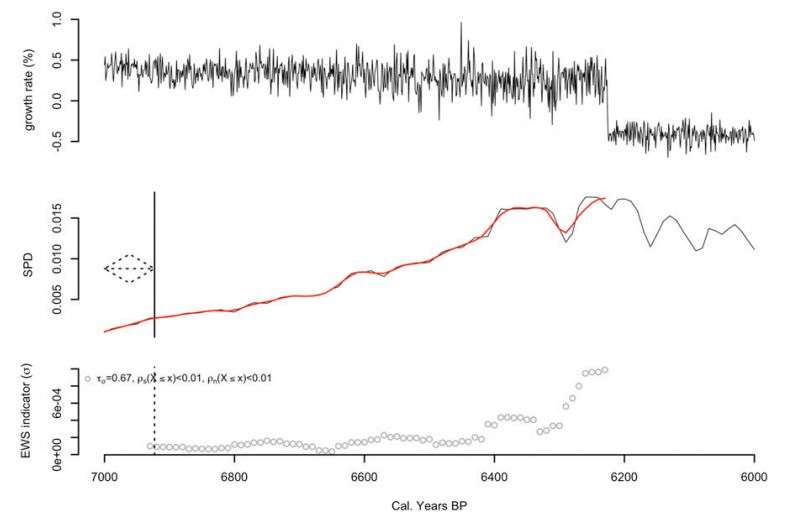August 30, 2016 report
Statistical study offers evidence of warning signs before Neolithic community collapse

(Phys.org)—A trio of researchers, two with the University of Maryland and the other with University College London has found that early Neolithic communities exhibited warning signs before collapsing. In their paper published in Proceedings of the National Academy of Sciences, Sean Downey, W. Randall Haas, Jr. and Stephen Shennan describe the statistical analysis they conducted on data that has been collected through prior efforts from Neolithic communities that existed approximately 9,000 years ago and what they learned as a result.
Knowing when a given community, town or city is about to collapse could prove useful in the future as the planet continues to warm—how such communities responded to stresses that have occurred in the past, the researchers found, may offer clues to the robustness of modern communities.
The European Neolithic was a time of huge population growth as agriculture allowed people to move into larger and larger communities and that allowed for technological advancement as many people discovered they no longer needed to spend their days hunting or growing food. But it was also a time of instability as increased population densities allowed diseases to spread more easily. There was also war and the always problematic unpredictable weather. Sometimes, such events led to the total collapse of a community. But before that happened, the researchers with this new effort contend, there were warning signs.
To learn more about societal collapse during the Neolithic, the researchers pored over papers documenting archeological digs looking for population numbers along with information regarding evidence of prior events that may have signaled coming trouble. The focus of their research was how communities had responded to stresses in their recent past. Those that were not able to fully recover between events, they noted, were at the most risk of total collapse when a new event occurred. They dubbed such events early warning signals (EWSs). They then tried the opposite approach, looking first for EWSs for a given community and then using them to try to predict whether a given community eventually collapsed—they report that they found such signals to be remarkably accurate. They suggest similar models could be used to help predict which if any modern communities may be in for a similar fate.
More information: Sean S. Downey et al. European Neolithic societies showed early warning signals of population collapse, Proceedings of the National Academy of Sciences (2016). DOI: 10.1073/pnas.1602504113
Abstract
Ecosystems on the verge of major reorganization—regime shift—may exhibit declining resilience, which can be detected using a collection of generic statistical tests known as early warning signals (EWSs). This study explores whether EWSs anticipated human population collapse during the European Neolithic. It analyzes recent reconstructions of European Neolithic (8–4 kya) population trends that reveal regime shifts from a period of rapid growth following the introduction of agriculture to a period of instability and collapse. We find statistical support for EWSs in advance of population collapse. Seven of nine regional datasets exhibit increasing autocorrelation and variance leading up to collapse, suggesting that these societies began to recover from perturbation more slowly as resilience declined. We derive EWS statistics from a prehistoric population proxy based on summed archaeological radiocarbon date probability densities. We use simulation to validate our methods and show that sampling biases, atmospheric effects, radiocarbon calibration error, and taphonomic processes are unlikely to explain the observed EWS patterns. The implications of these results for understanding the dynamics of Neolithic ecosystems are discussed, and we present a general framework for analyzing societal regime shifts using EWS at large spatial and temporal scales. We suggest that our findings are consistent with an adaptive cycling model that highlights both the vulnerability and resilience of early European populations. We close by discussing the implications of the detection of EWS in human systems for archaeology and sustainability science.
Journal information: Proceedings of the National Academy of Sciences
© 2016 Phys.org


















